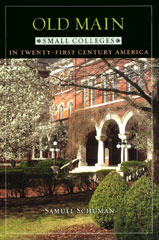

Centenary
News Service
2911 Centenary
Boulevard
Post Office
Box 4188
Shreveport
Louisiana
71134-1188
Telephone
318 869-5120
Fax
318 841-7266
Email
news@centenary.edu
FOR IMMEDIATE RELEASE (7/27/05)
Contact: Lynn Stewart, Centenary News Service, 318-869-5120
New Book about Small Colleges includes Centenary among 12 Featured

SHREVEPORT, LA -- Centenary College is one of 12 institutions featured
in a new book about small colleges in America. Old Main: Small Colleges
in 21st Century America by Samuel Schuman is just out this week from
the Johns Hopkins University Press.
Schuman, who is the chancellor of the University of Minnesota’s
Morris campus, visited and studied each of the dozen colleges to write
about the current conditions and future possibilities of small colleges.
“This perceptive account of small colleges in America draws on key
data and firsthand observations to explain how and why, when it comes
to colleges, size matters – to students, to faculty, to administrators,
to education,” says the book jacket text.
Schuman’s thesis is that small colleges were, for most of U.S. history,
the “main” thread of the nation’s higher education system,
but their centrality has been largely lost to large universities.
“Bluntly, it is not my thesis that small colleges are ‘better’
than large universities,” Schuman writes. “It is my contention
that they are different in kind as well as volume, and that for some undergraduates
(and I was one such) they are the best educational option.”
In addition to Centenary, the book features detailed information about
Colby-Sawyer College in New Hampshire, the College of New Rochelle in
New York, George Fox University in Oregon, Grinnell College in Iowa, Minneapolis
College of Art and Design in Minnesota, Morehouse College in Georgia,
Southwestern University in Texas, Warren Wilson College in North Carolina,
Wellesley College in Massachusetts, Westmont College in California and
the University of Wisconsin-Superior.
Schuman points out that the group includes a wide range of missions, history,
geography, population, prestige, size and wealth. However, he said, the
statistical data shows a remarkable correlation in such areas as size
of endowment, tuition rate, first-year retention and faculty salaries.
In his appendix area, describing each institution, Schuman cites Centenary,
the oldest college among his sample, for its atmosphere, campus facilities,
history, aspirations and challenges as “the most characteristic
of typical small colleges today.” He states that the college “prides
itself on a tradition of service and ethical cultivation,” and points
to the “lush greenery of the campus” and its “equally
lush cordiality and friendliness of the collegiate atmosphere.”
He writes that “Centenary seems to the visitor a school with a strong
and positive regional repute, a school that would very much like to move
to a more national stage.”
“Somewhat quirky” was Schuman’s characterization for
Centenary’s maintaining an NCAA Division I intercollegiate athletic
program. “It is the smallest institution in the nation in that category.”
The book also contains a passage from A Burning Torch and a Flaming
Fire, a 1931 history of Centenary by William Hamilton Nelson. The
passage describes the graduation exercises at Centenary in 1900. “Reflecting
on the historical development of small colleges, it seems appropriate
to consider a personal narrative, which catches wonderfully the flavor
of small, church-related colleges at the turn of the 20th century,”
Schuman wrote.
Discussing the “size variable” among institutions, Schuman
asserts that smallness is significant, as is curricular emphasis and the
public or private oversight of a college or university. He offers evidence
that small colleges really are different and that the difference is good
for students.
Old Main includes a survey of the history of American higher
education “from the somewhat unusual vantage point of the evolution
of small colleges” and it looks at ways small institutions are distinctive,
even among themselves. Schuman also gives an overview of small colleges'
students, faculty and staff and discusses their shared characteristics
and the values they bring to the fabric of the nation’s postsecondary
scene, “particularly in the two areas I am calling ‘community’
and ‘integrity.’”
He also gives examples of how small colleges and large universities are
trying to learn from one another and gives thoughts about how the values
of small colleges are connected to other aspects of contemporary American
life.
The book is printed by the Johns Hopkins University Press, Baltimore and
London. For additional information, see http://www.press.jhu.edu/books/title_pages/3322.html.
- 30 -